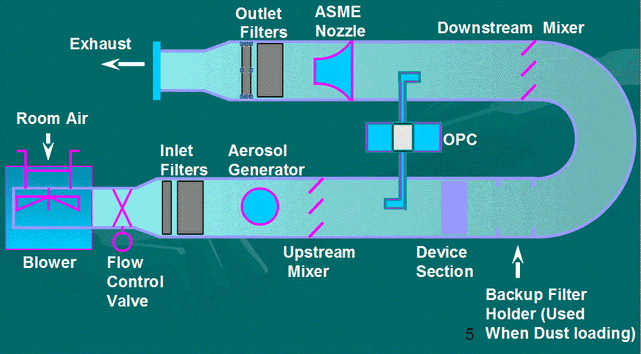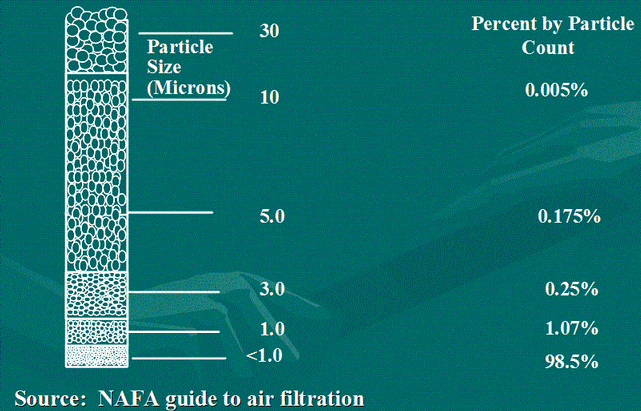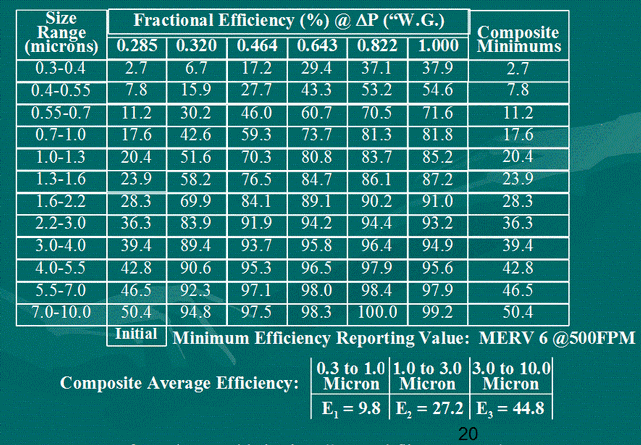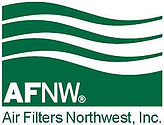What is MERV?
Home > What is MERV?
TEST METHOD
52.2-1999
M.E.R.V.
A practical look at ASHRAE 52.2 -1999 “Method of testing general ventilation air-cleaning devices for removal efficiency by particle size”
Minimum – worst case scenario
- Efficiency – based upon specific particle size challenge
- Reported –12 sets of particle sizes in three groups of four sets to make ranges E-1 (.3-1 micron), E-2 (1-3 microns), E-3 (3-10 microns)
- Value – tested upstream vs. downstream and given as a percentage performance
- ASHRAE 52.2-1999
- Particle size performance
- Minimum efficiency
- Tested to maximum airflow advertised
- Tested to realistic pressure drops
- Consistent test aerosol
- ASHRAE 52.1-1992
- Dust spot efficiency
- Average efficiencies
- Moving pressure drop values
- Atmospheric challenge changes
- Dust Holding Capacity

ASHRAE Test Method 52.2-1999 uses Neutralized dust meaning that the natural positive and negative charges in the atmosphere are diminished in the test
This could have a different effect on efficiency compared to natures effects
Average Efficiency?
Q: When is a 95% filter not a 95% filter?
A: When it is new, it is not 95% per ASHRAE test method 52.1-1992 (Dust Spot Efficiency)
The top five 95% V-cell filters today have an initial efficiency of 57 – 81%* on their best distributed test report
* – Per ASHRAE Standard 52.1-1992
Determine the NEED
The particle size which causes problems varies from industry to industry and methods or purpose of use
Once we determine the particle size we can choose a filtration efficiency – M.E.R.V.
WHO Sets the Particle Size?
Industries that know what the killer defect size particle is, require filtration systems to remove those particles from the air…
- Healthcare and Hospitals
- Semi-conductor Industry
- School Districts and Universities
- Commercial & Industrial Real Estate
Size Distribution of Atmospheric Dust Sample

- E-3 particles between 3 and 10 microns
- E-2 particles between 1 and 3 microns
- E-1 particles between 0.3 and 1 micron
M.E.R.V. 1 – 4
- Filters that fit within the 1 – 4 category are not tested by ASHRAE 52.2-1999 test procedure. Rather the Standard refers them back to ASHRAE 52.1-1992
- Less than 20% Efficient on E-3 (3-10 microns) range
- These are the historic arrestance type filters – autorolls, metal washables, etc
M.E.R.V. 5 – 8
- Starting above 20% on the E-3 (3-10 microns) range
- M.E.R.V. 5 must be 20-35%
- M.E.R.V. 6 must be 35-50%
- M.E.R.V. 7 must be 50-70%
- M.E.R.V. 8 must be above 70%
M.E.R.V. 9 – 12
- Measurable efficiency on the E-2 (1-3 microns) range and a minimum of 85% or more on E-3 (3-10 microns)
- M.E.R.V. 9 must be up to 50%
- M.E.R.V. 10 must be 50-65%
- M.E.R.V. 11 must be 65-80%
- M.E.R.V. 12 must be more than 80%
M.E.R.V. 13 – 16
- Measurable efficiency in submicron E-1 (.3-1 micron) and more than 90% in the E-2 (1-3 microns) and E-3 (3-10 microns)
- M.E.R.V. 13 is up to 75%
- M.E.R.V. 14 must be 75-85%
- M.E.R.V. 15 must be 85-95%
- M.E.R.V. 16 must be at least 95% in all categories E-1 (.3-1 micron), E-2 (1-3 microns) and E3 (3-10 microns)
M.E.R.V. Reporting
M.E.R.V. Reporting
What does the 52.2-1999 Test Method Provide?

DHC – dust holding capacity
Research is looking for a more realistic loading dust to make the value relate to atmospheric dust loading
Has not been released for public review yet
ASHRAE 52.2-1999 Test Method Users Guide
Simple explanation of test procedure
Has all the ranges and particle size info
Rough equations to ASHRAE 52.1-1992 efficiency
And examples of the uses
